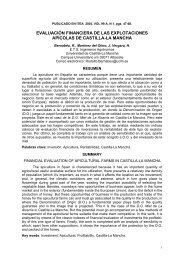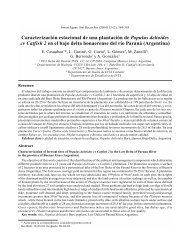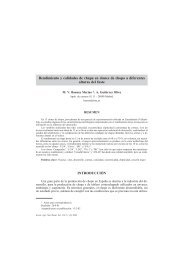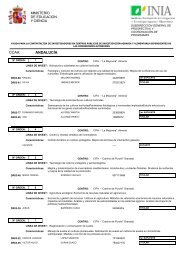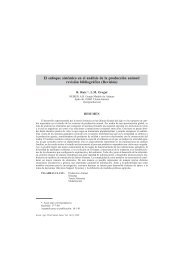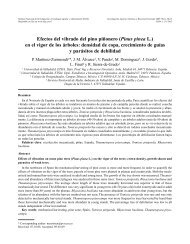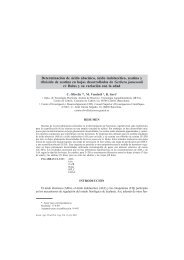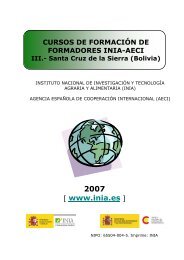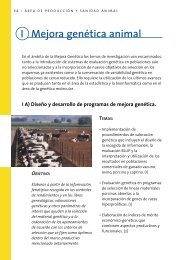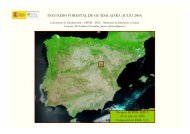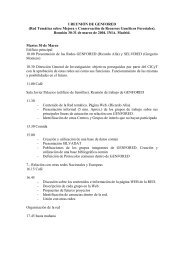Status of medicinal and aromatic plants in - Inia
Status of medicinal and aromatic plants in - Inia
Status of medicinal and aromatic plants in - Inia
You also want an ePaper? Increase the reach of your titles
YUMPU automatically turns print PDFs into web optimized ePapers that Google loves.
94<br />
WORKING GROUP ON MEDICINAL AND AROMATIC PLANTS: FIRST MEETING<br />
Cultivation <strong>of</strong> several <strong>medic<strong>in</strong>al</strong> <strong>plants</strong> has been started by the requirements <strong>of</strong> the<br />
domestic medical <strong>in</strong>dustry. Alcoholic extracts, tablets <strong>and</strong> other special products are<br />
produced from Ech<strong>in</strong>acea purpurea, Solidago virgaurea, Rhodiola rosea, Plantago lanceolata, etc.<br />
The quantities <strong>of</strong> these <strong>plants</strong> together are variable (ca. 15-30 t/year).<br />
Experiences <strong>in</strong> susta<strong>in</strong>able use <strong>of</strong> MAPs<br />
• Organic production<br />
Organic production is exp<strong>and</strong><strong>in</strong>g cont<strong>in</strong>uously <strong>in</strong> F<strong>in</strong>l<strong>and</strong>. In 1998 the total organic area<br />
controlled by the local authorities was 126 000 ha. Organic herb production is <strong>in</strong>creas<strong>in</strong>g, but<br />
is still very small: the organic <strong>and</strong> convert<strong>in</strong>g area was 71 ha <strong>in</strong> 1995, 121 ha <strong>in</strong> 1997 <strong>and</strong><br />
228 ha <strong>in</strong> 2001.<br />
S<strong>in</strong>ce the health drug stores require organically grown raw materials, all <strong>medic<strong>in</strong>al</strong> <strong>plants</strong><br />
are grown organically. F<strong>in</strong>nish consumers prefer herbicide-free products, therefore the local<br />
producers grow herbs us<strong>in</strong>g organic cultivation methods. S<strong>in</strong>ce weed control is not<br />
mechanized <strong>in</strong> organic cultivation, the production units <strong>and</strong> quantities produced rema<strong>in</strong><br />
small.<br />
The areas <strong>of</strong> organically grown mustard, caraway <strong>and</strong> cori<strong>and</strong>er are between 3-12 ha, dill<br />
<strong>and</strong> m<strong>in</strong>t about 5 ha, <strong>and</strong> those <strong>of</strong> nearly 20 other herbs about 0.5-3 ha.<br />
• Susta<strong>in</strong>able collect<strong>in</strong>g <strong>of</strong> herbs<br />
In the guide for wild herb collect<strong>in</strong>g (Mäk<strong>in</strong>en et al. 1994) general <strong>in</strong>structions are given for<br />
susta<strong>in</strong>able collect<strong>in</strong>g methods. These <strong>in</strong>structions were given <strong>in</strong> more detail <strong>in</strong> some cases,<br />
e.g. Drosera rotundifolia, which is collected <strong>in</strong> quite large quantities regularly.<br />
Dur<strong>in</strong>g 1993-1999 the effect <strong>of</strong> regular collect<strong>in</strong>g on the regeneration <strong>of</strong> natural<br />
populations <strong>of</strong> Drosera rotundifolia were studied (Galambosi et al. 2000). The results showed<br />
that after two years <strong>of</strong> collect<strong>in</strong>g, the density <strong>of</strong> the plant populations <strong>and</strong> the available fresh<br />
yields had decreased by 50%. On the basis <strong>of</strong> these results, a new environmentally<br />
susta<strong>in</strong>able collect<strong>in</strong>g method was developed <strong>and</strong> applied by the collectors.<br />
As shown by the results <strong>of</strong> the experiment, sundew populations seem to regenerate by<br />
seed. Therefore the F<strong>in</strong>nish 4H Association immediately elaborated a new, environmentally<br />
susta<strong>in</strong>able collect<strong>in</strong>g programme for young collectors to m<strong>in</strong>imize the harmful effects <strong>of</strong><br />
collect<strong>in</strong>g <strong>and</strong> ensure safe regeneration <strong>of</strong> natural populations. Accord<strong>in</strong>g to the new<br />
guidel<strong>in</strong>es, the collector must leave 5-10 flower<strong>in</strong>g <strong>plants</strong> per square metre on the peatl<strong>and</strong>.<br />
In theory, this leaves about 400-900 seeds/m 2 . Additionally, sundew may be collected only<br />
once <strong>in</strong> the summer from each site. Accord<strong>in</strong>g to our results, 35% <strong>of</strong> the whole population<br />
flowered after the first collect<strong>in</strong>g. Follow<strong>in</strong>g the new guidel<strong>in</strong>es, also later-flower<strong>in</strong>g <strong>plants</strong><br />
can produce seeds safely, disperse them <strong>and</strong> ensure the natural regeneration <strong>of</strong> sundew<br />
populations. These <strong>in</strong>structions are emphasized <strong>in</strong> collectors' tra<strong>in</strong><strong>in</strong>g programmes.<br />
• Production-oriented dynamic preservation <strong>of</strong> threatened <strong>medic<strong>in</strong>al</strong> <strong>plants</strong><br />
Accord<strong>in</strong>g to a recent study <strong>of</strong> the commercial importance <strong>and</strong> threatened status <strong>of</strong><br />
<strong>medic<strong>in</strong>al</strong> <strong>plants</strong> <strong>in</strong> Europe, about 150 species were reported to be threatened <strong>in</strong> at least one<br />
European country as a result <strong>of</strong> over-collect<strong>in</strong>g from the wild (Lange 1998). Some <strong>of</strong> the<br />
threatened <strong>medic<strong>in</strong>al</strong> <strong>plants</strong> are cold-tolerant or belong to the orig<strong>in</strong>al F<strong>in</strong>nish flora.<br />
A series <strong>of</strong> 3-year cultivation experiments were carried out <strong>in</strong> F<strong>in</strong>l<strong>and</strong> to study the<br />
suitability <strong>of</strong> several cold-tolerant <strong>medic<strong>in</strong>al</strong> <strong>plants</strong> for cultivation <strong>and</strong> possible raw material<br />
production (Bernáth 1988). Reasonable yields were obta<strong>in</strong>ed <strong>in</strong> southern F<strong>in</strong>l<strong>and</strong> from the<br />
follow<strong>in</strong>g species <strong>in</strong> organic conditions: Achillea ptarmica, Acorus calamus, Alchemilla alp<strong>in</strong>a, A.<br />
xanthochlora, Arnica montana, Gentiana lutea, Herniaria glabra, Leontopodium alp<strong>in</strong>um, Primula<br />
veris <strong>and</strong> Rhodiola rosea. After 3-year grow<strong>in</strong>g observations, Antennaria dioica, Asarum




